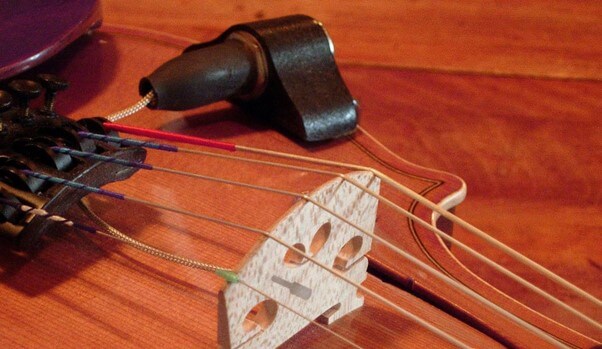
Contents
Last Updated on 5th July 2023
The first versions of stringed instruments were developed in ancient civilizations such as the Babylonians and Egyptians. The modern violin and guitar were likely developed in the 16th century, versions of Lutes to create different sounds.
Introduction: The Evolution of Electric Violins
Over the centuries, the violin has established itself as a beloved and versatile instrument, capable of producing breath-taking melodies and captivating audiences worldwide. It’s often integral to classical music pieces from composers like Bach, Mozat and Brahms. And instrumental to whole genres like Cèilidh bands and Irish folk.
As early as the 1920s electric violin were beginning to develop with the advent of the pickup and electronic amplification.
Similar to the electric guitar, electric violins were developed first as a response to the limitations of traditional acoustic violins in certain settings, such as a solo instrument in large concert halls. Again, similar to the guitar, this would have been a standard acoustic instrument with a pickup on it.

Technology: Exploring the Inner Workings
At the heart of an electric violin is the pickup system. Traditional violins produce sound through the resonance of the hollow body, but electric violins rely on pickups to capture the vibrations of the strings.
The most common type of pickup used in electric violins is the electromagnetic pickup. It consists of a coil of wire wrapped around a magnet, which generates an electrical current as the strings’ vibrations disturb the magnetic field. This current is then sent to an amplifier for further processing.
Piezoelectric pickups are another popular choice for electric violins. These pickups consist of piezoelectric crystals or materials that generate an electrical charge in response to mechanical pressure. Placed beneath the bridge or in contact with the strings, they convert the mechanical vibrations into electrical signals, which are then amplified.
Modern electric violins often feature a combination of different pickup systems to achieve a wider tonal range and greater versatility. This allows musicians to experiment with different sound characteristics and tailor their instrument’s output to their preferences.
Amplification
To amplify the electric violin’s signal, musicians typically connect their instrument to an amplifier or PA. The amplifier boosts the electrical signals from the pickups to audible levels and allows the sound to be projected to a larger audience. Some electric violins even have built-in preamps and outputs, eliminating the need for external amplifiers.
Technological advancements have also led to the incorporation of wireless connectivity in electric violins. This allows musicians to move freely on stage without being constrained by cables. Wireless systems transmit the audio signal from the instrument to the receiver, ensuring a seamless and untethered performance.
Evolution

The design of the violin is now free of the constraint of having to produce acoustic amplification through a sound chamber.
Electric violins, with their sleek and futuristic designs, differ from traditional acoustic violins not only in terms of technology but also in the materials used and their overall shape.
When it comes to materials, electric violins often feature a combination of traditional woods, such as maple, spruce, and ebony, along with modern materials like carbon fibre and composite materials.
While some electric violins maintain the classic violin shape, others feature more streamlined and ergonomic designs. The unique shapes are often intended to improve playability, balance and to accommodate additional features, such as onboard controls, jacks for connecting to amplifiers or sound systems, and space for batteries or electronics.
Now that the violin output is an electronic signal, similar to the guitar, effects pedals such as reverb, echo and even distortion can be used to great effect by the more experimental player
The Violin in Modern “Non-classical“ Music
In jazz, electric violins have become integral to the genre’s evolution, contributing to its fusion with various styles. Jazz violinists like Jean-Luc Ponty and Regina Carter have showcased the instrument’s agility and improvisational potential, infusing their performances with captivating solos and melodic explorations.
Electric violins in jazz offer a rich palette of tonal colours, allowing musicians to experiment with different effects and techniques to create a distinctively modern jazz sound.
In more mainstream pop and rock, the Electric Light Orchestra’s Mike Kaminski was the forefront of using the electronic instrument.

The Future
Overall, the future of the electric violin is bright and promising.
As technology advances and musicians continue to explore new possibilities, we can anticipate further innovation, enhanced performance capabilities, and a broader range of artistic expressions.
The electric violin will undoubtedly continue to captivate audiences, push musical boundaries, and leave an indelible mark on the music landscape.
How do you get the range of sounds from the electric violin?
The acoustic electric violin can produce a wide range of sounds and effects, these may include:
- Bowing: The bow is used to create sound by drawing it across the strings, such as long, smooth strokes, short and quick strokes, or varying the pressure on the strings to create different dynamics.
- Pizzicato: Where you pluck the strings with your fingers instead of using the bow to produce a percussive sound.
- Vibrato: Add vibrato by slightly oscillating the finger on the string while maintaining the pitch.
- Effects: Take advantage of the electric violin’s electronic capabilities by using effects pedals or manipulating the sound settings on your amplifier. This can include adding reverb, distortion, delay, or other effects to create unique sounds.

































